Commercial Law Assignment: Analysis of Contract Law Issues
VerifiedAdded on 2021/06/15
|8
|2260
|57
Homework Assignment
AI Summary
This assignment analyzes a commercial law case involving contract law principles. Part A examines the Indian legal system through Hart's three-part legal system framework, comparing it to Australia's. Part B addresses a scenario where Barry enters a contract with Angelo. The assignment assesses the validity of the contract, focusing on misrepresentation and its elements, including false statements and inducement to contract. It further explores potential breaches of contract, distinguishing between express and implicit terms, and evaluates the significance of representations made during negotiations. The analysis considers factors like the expertise of the representor and the importance of the representation to the representee. The assignment concludes by determining the contract's voidability and potential damages, referencing relevant legal provisions like the ACL.
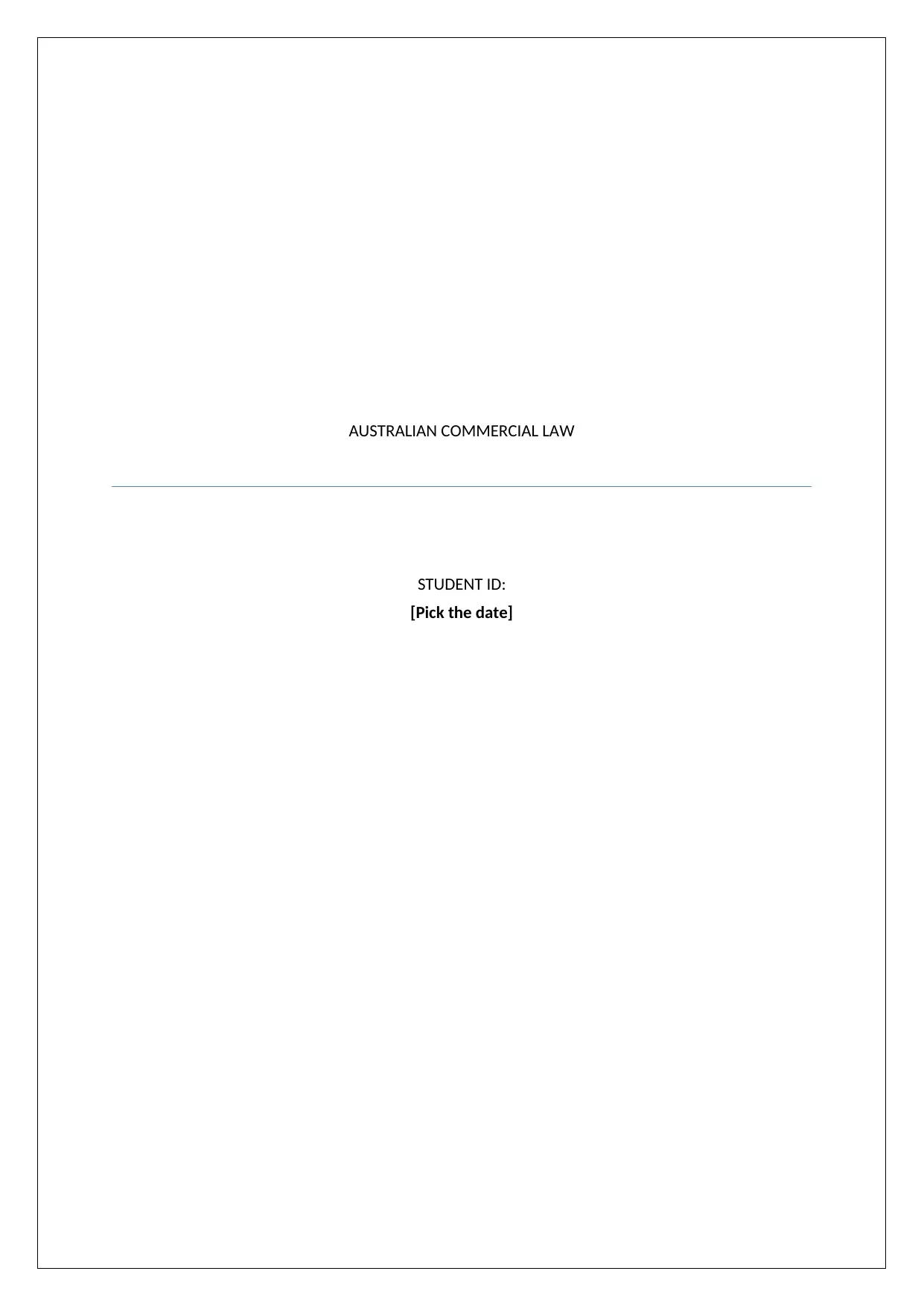
AUSTRALIAN COMMERCIAL LAW
STUDENT ID:
[Pick the date]
STUDENT ID:
[Pick the date]
Paraphrase This Document
Need a fresh take? Get an instant paraphrase of this document with our AI Paraphraser
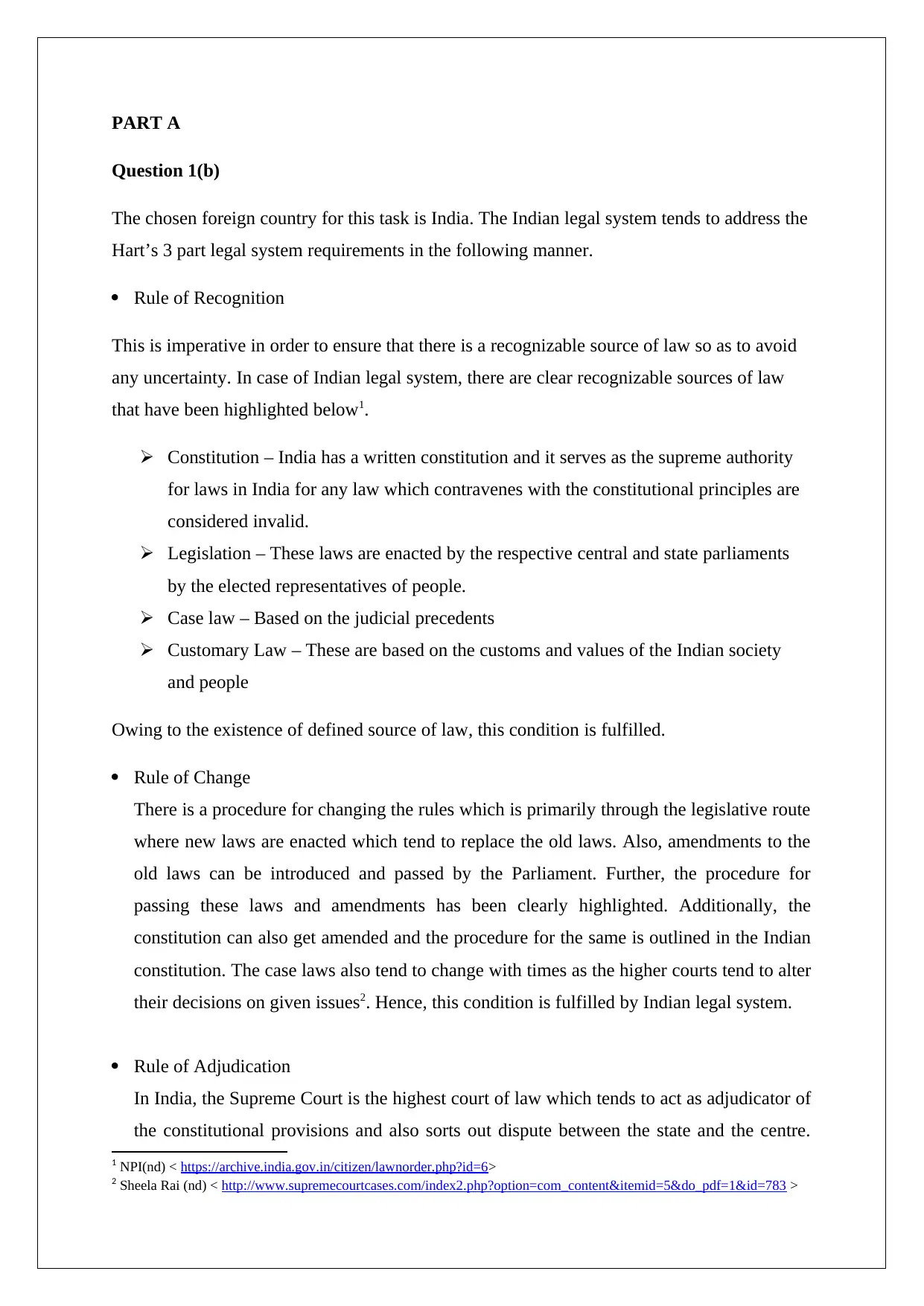
PART A
Question 1(b)
The chosen foreign country for this task is India. The Indian legal system tends to address the
Hart’s 3 part legal system requirements in the following manner.
Rule of Recognition
This is imperative in order to ensure that there is a recognizable source of law so as to avoid
any uncertainty. In case of Indian legal system, there are clear recognizable sources of law
that have been highlighted below1.
Constitution – India has a written constitution and it serves as the supreme authority
for laws in India for any law which contravenes with the constitutional principles are
considered invalid.
Legislation – These laws are enacted by the respective central and state parliaments
by the elected representatives of people.
Case law – Based on the judicial precedents
Customary Law – These are based on the customs and values of the Indian society
and people
Owing to the existence of defined source of law, this condition is fulfilled.
Rule of Change
There is a procedure for changing the rules which is primarily through the legislative route
where new laws are enacted which tend to replace the old laws. Also, amendments to the
old laws can be introduced and passed by the Parliament. Further, the procedure for
passing these laws and amendments has been clearly highlighted. Additionally, the
constitution can also get amended and the procedure for the same is outlined in the Indian
constitution. The case laws also tend to change with times as the higher courts tend to alter
their decisions on given issues2. Hence, this condition is fulfilled by Indian legal system.
Rule of Adjudication
In India, the Supreme Court is the highest court of law which tends to act as adjudicator of
the constitutional provisions and also sorts out dispute between the state and the centre.
1 NPI(nd) < https://archive.india.gov.in/citizen/lawnorder.php?id=6>
2 Sheela Rai (nd) < http://www.supremecourtcases.com/index2.php?option=com_content&itemid=5&do_pdf=1&id=783 >
Question 1(b)
The chosen foreign country for this task is India. The Indian legal system tends to address the
Hart’s 3 part legal system requirements in the following manner.
Rule of Recognition
This is imperative in order to ensure that there is a recognizable source of law so as to avoid
any uncertainty. In case of Indian legal system, there are clear recognizable sources of law
that have been highlighted below1.
Constitution – India has a written constitution and it serves as the supreme authority
for laws in India for any law which contravenes with the constitutional principles are
considered invalid.
Legislation – These laws are enacted by the respective central and state parliaments
by the elected representatives of people.
Case law – Based on the judicial precedents
Customary Law – These are based on the customs and values of the Indian society
and people
Owing to the existence of defined source of law, this condition is fulfilled.
Rule of Change
There is a procedure for changing the rules which is primarily through the legislative route
where new laws are enacted which tend to replace the old laws. Also, amendments to the
old laws can be introduced and passed by the Parliament. Further, the procedure for
passing these laws and amendments has been clearly highlighted. Additionally, the
constitution can also get amended and the procedure for the same is outlined in the Indian
constitution. The case laws also tend to change with times as the higher courts tend to alter
their decisions on given issues2. Hence, this condition is fulfilled by Indian legal system.
Rule of Adjudication
In India, the Supreme Court is the highest court of law which tends to act as adjudicator of
the constitutional provisions and also sorts out dispute between the state and the centre.
1 NPI(nd) < https://archive.india.gov.in/citizen/lawnorder.php?id=6>
2 Sheela Rai (nd) < http://www.supremecourtcases.com/index2.php?option=com_content&itemid=5&do_pdf=1&id=783 >
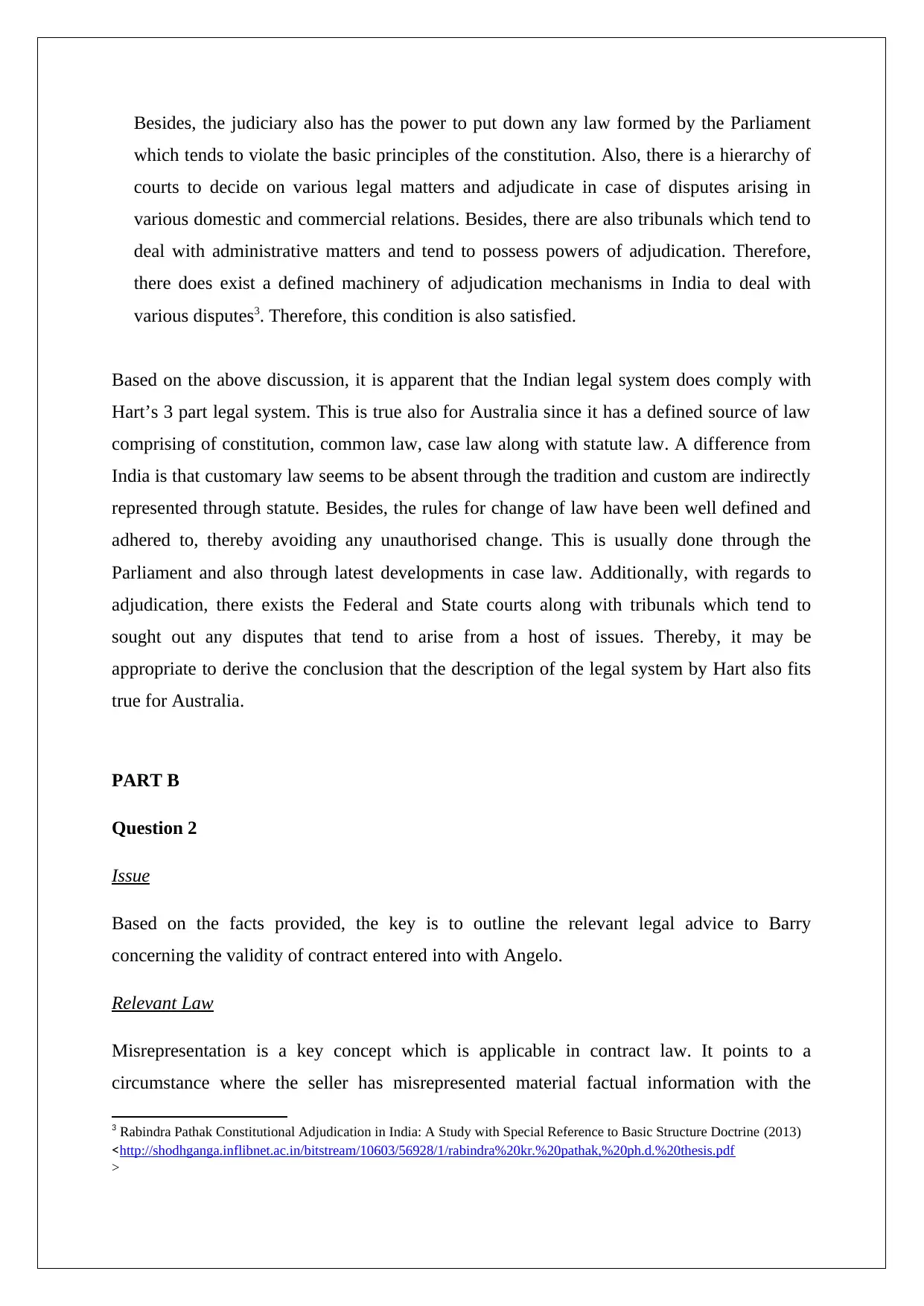
Besides, the judiciary also has the power to put down any law formed by the Parliament
which tends to violate the basic principles of the constitution. Also, there is a hierarchy of
courts to decide on various legal matters and adjudicate in case of disputes arising in
various domestic and commercial relations. Besides, there are also tribunals which tend to
deal with administrative matters and tend to possess powers of adjudication. Therefore,
there does exist a defined machinery of adjudication mechanisms in India to deal with
various disputes3. Therefore, this condition is also satisfied.
Based on the above discussion, it is apparent that the Indian legal system does comply with
Hart’s 3 part legal system. This is true also for Australia since it has a defined source of law
comprising of constitution, common law, case law along with statute law. A difference from
India is that customary law seems to be absent through the tradition and custom are indirectly
represented through statute. Besides, the rules for change of law have been well defined and
adhered to, thereby avoiding any unauthorised change. This is usually done through the
Parliament and also through latest developments in case law. Additionally, with regards to
adjudication, there exists the Federal and State courts along with tribunals which tend to
sought out any disputes that tend to arise from a host of issues. Thereby, it may be
appropriate to derive the conclusion that the description of the legal system by Hart also fits
true for Australia.
PART B
Question 2
Issue
Based on the facts provided, the key is to outline the relevant legal advice to Barry
concerning the validity of contract entered into with Angelo.
Relevant Law
Misrepresentation is a key concept which is applicable in contract law. It points to a
circumstance where the seller has misrepresented material factual information with the
3 Rabindra Pathak Constitutional Adjudication in India: A Study with Special Reference to Basic Structure Doctrine (2013)
<http://shodhganga.inflibnet.ac.in/bitstream/10603/56928/1/rabindra%20kr.%20pathak,%20ph.d.%20thesis.pdf
>
which tends to violate the basic principles of the constitution. Also, there is a hierarchy of
courts to decide on various legal matters and adjudicate in case of disputes arising in
various domestic and commercial relations. Besides, there are also tribunals which tend to
deal with administrative matters and tend to possess powers of adjudication. Therefore,
there does exist a defined machinery of adjudication mechanisms in India to deal with
various disputes3. Therefore, this condition is also satisfied.
Based on the above discussion, it is apparent that the Indian legal system does comply with
Hart’s 3 part legal system. This is true also for Australia since it has a defined source of law
comprising of constitution, common law, case law along with statute law. A difference from
India is that customary law seems to be absent through the tradition and custom are indirectly
represented through statute. Besides, the rules for change of law have been well defined and
adhered to, thereby avoiding any unauthorised change. This is usually done through the
Parliament and also through latest developments in case law. Additionally, with regards to
adjudication, there exists the Federal and State courts along with tribunals which tend to
sought out any disputes that tend to arise from a host of issues. Thereby, it may be
appropriate to derive the conclusion that the description of the legal system by Hart also fits
true for Australia.
PART B
Question 2
Issue
Based on the facts provided, the key is to outline the relevant legal advice to Barry
concerning the validity of contract entered into with Angelo.
Relevant Law
Misrepresentation is a key concept which is applicable in contract law. It points to a
circumstance where the seller has misrepresented material factual information with the
3 Rabindra Pathak Constitutional Adjudication in India: A Study with Special Reference to Basic Structure Doctrine (2013)
<http://shodhganga.inflibnet.ac.in/bitstream/10603/56928/1/rabindra%20kr.%20pathak,%20ph.d.%20thesis.pdf
>
⊘ This is a preview!⊘
Do you want full access?
Subscribe today to unlock all pages.

Trusted by 1+ million students worldwide
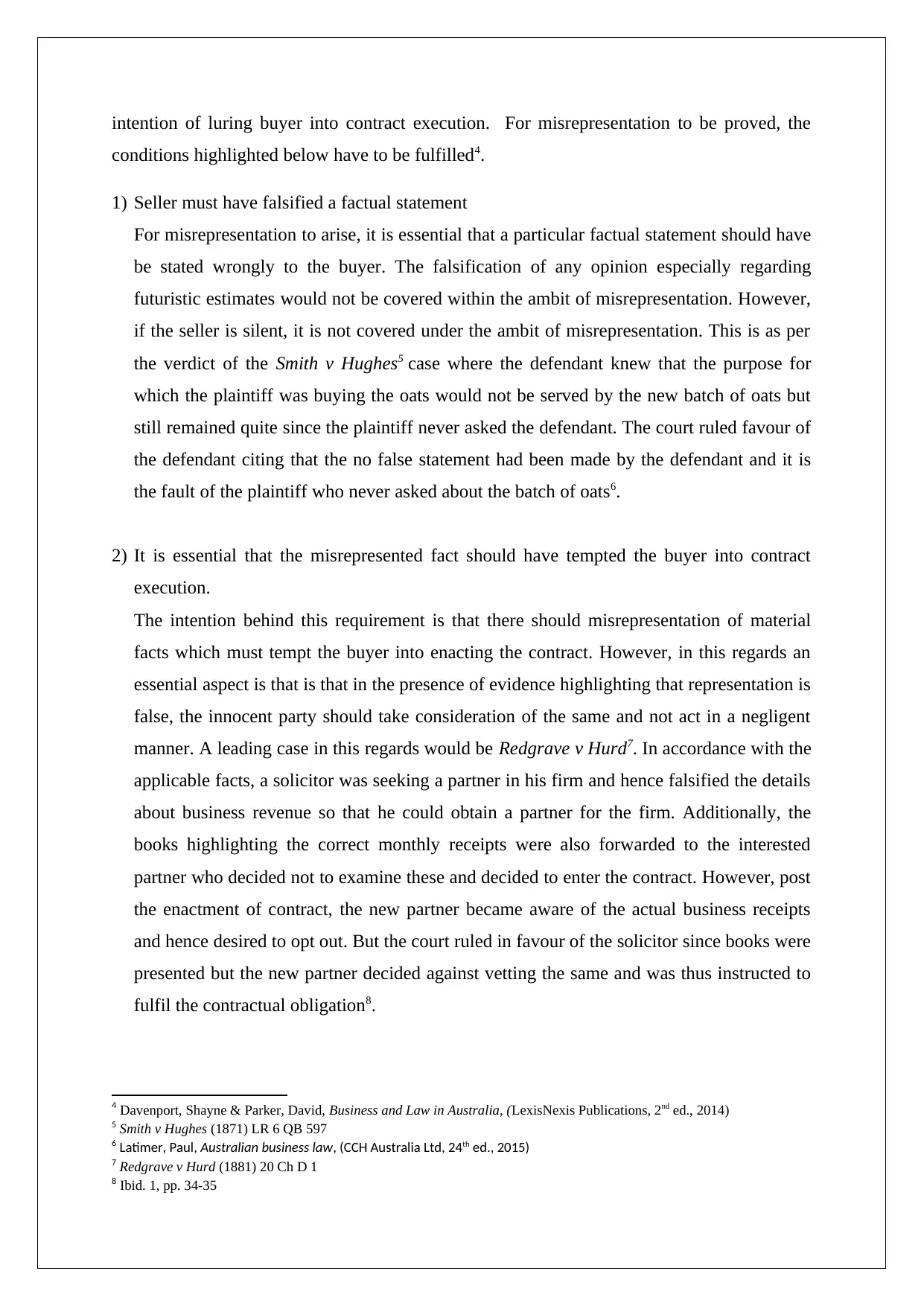
intention of luring buyer into contract execution. For misrepresentation to be proved, the
conditions highlighted below have to be fulfilled4.
1) Seller must have falsified a factual statement
For misrepresentation to arise, it is essential that a particular factual statement should have
be stated wrongly to the buyer. The falsification of any opinion especially regarding
futuristic estimates would not be covered within the ambit of misrepresentation. However,
if the seller is silent, it is not covered under the ambit of misrepresentation. This is as per
the verdict of the Smith v Hughes5 case where the defendant knew that the purpose for
which the plaintiff was buying the oats would not be served by the new batch of oats but
still remained quite since the plaintiff never asked the defendant. The court ruled favour of
the defendant citing that the no false statement had been made by the defendant and it is
the fault of the plaintiff who never asked about the batch of oats6.
2) It is essential that the misrepresented fact should have tempted the buyer into contract
execution.
The intention behind this requirement is that there should misrepresentation of material
facts which must tempt the buyer into enacting the contract. However, in this regards an
essential aspect is that is that in the presence of evidence highlighting that representation is
false, the innocent party should take consideration of the same and not act in a negligent
manner. A leading case in this regards would be Redgrave v Hurd7. In accordance with the
applicable facts, a solicitor was seeking a partner in his firm and hence falsified the details
about business revenue so that he could obtain a partner for the firm. Additionally, the
books highlighting the correct monthly receipts were also forwarded to the interested
partner who decided not to examine these and decided to enter the contract. However, post
the enactment of contract, the new partner became aware of the actual business receipts
and hence desired to opt out. But the court ruled in favour of the solicitor since books were
presented but the new partner decided against vetting the same and was thus instructed to
fulfil the contractual obligation8.
4 Davenport, Shayne & Parker, David, Business and Law in Australia, (LexisNexis Publications, 2nd ed., 2014)
5 Smith v Hughes (1871) LR 6 QB 597
6 Latimer, Paul, Australian business law, (CCH Australia Ltd, 24th ed., 2015)
7 Redgrave v Hurd (1881) 20 Ch D 1
8 Ibid. 1, pp. 34-35
conditions highlighted below have to be fulfilled4.
1) Seller must have falsified a factual statement
For misrepresentation to arise, it is essential that a particular factual statement should have
be stated wrongly to the buyer. The falsification of any opinion especially regarding
futuristic estimates would not be covered within the ambit of misrepresentation. However,
if the seller is silent, it is not covered under the ambit of misrepresentation. This is as per
the verdict of the Smith v Hughes5 case where the defendant knew that the purpose for
which the plaintiff was buying the oats would not be served by the new batch of oats but
still remained quite since the plaintiff never asked the defendant. The court ruled favour of
the defendant citing that the no false statement had been made by the defendant and it is
the fault of the plaintiff who never asked about the batch of oats6.
2) It is essential that the misrepresented fact should have tempted the buyer into contract
execution.
The intention behind this requirement is that there should misrepresentation of material
facts which must tempt the buyer into enacting the contract. However, in this regards an
essential aspect is that is that in the presence of evidence highlighting that representation is
false, the innocent party should take consideration of the same and not act in a negligent
manner. A leading case in this regards would be Redgrave v Hurd7. In accordance with the
applicable facts, a solicitor was seeking a partner in his firm and hence falsified the details
about business revenue so that he could obtain a partner for the firm. Additionally, the
books highlighting the correct monthly receipts were also forwarded to the interested
partner who decided not to examine these and decided to enter the contract. However, post
the enactment of contract, the new partner became aware of the actual business receipts
and hence desired to opt out. But the court ruled in favour of the solicitor since books were
presented but the new partner decided against vetting the same and was thus instructed to
fulfil the contractual obligation8.
4 Davenport, Shayne & Parker, David, Business and Law in Australia, (LexisNexis Publications, 2nd ed., 2014)
5 Smith v Hughes (1871) LR 6 QB 597
6 Latimer, Paul, Australian business law, (CCH Australia Ltd, 24th ed., 2015)
7 Redgrave v Hurd (1881) 20 Ch D 1
8 Ibid. 1, pp. 34-35
Paraphrase This Document
Need a fresh take? Get an instant paraphrase of this document with our AI Paraphraser
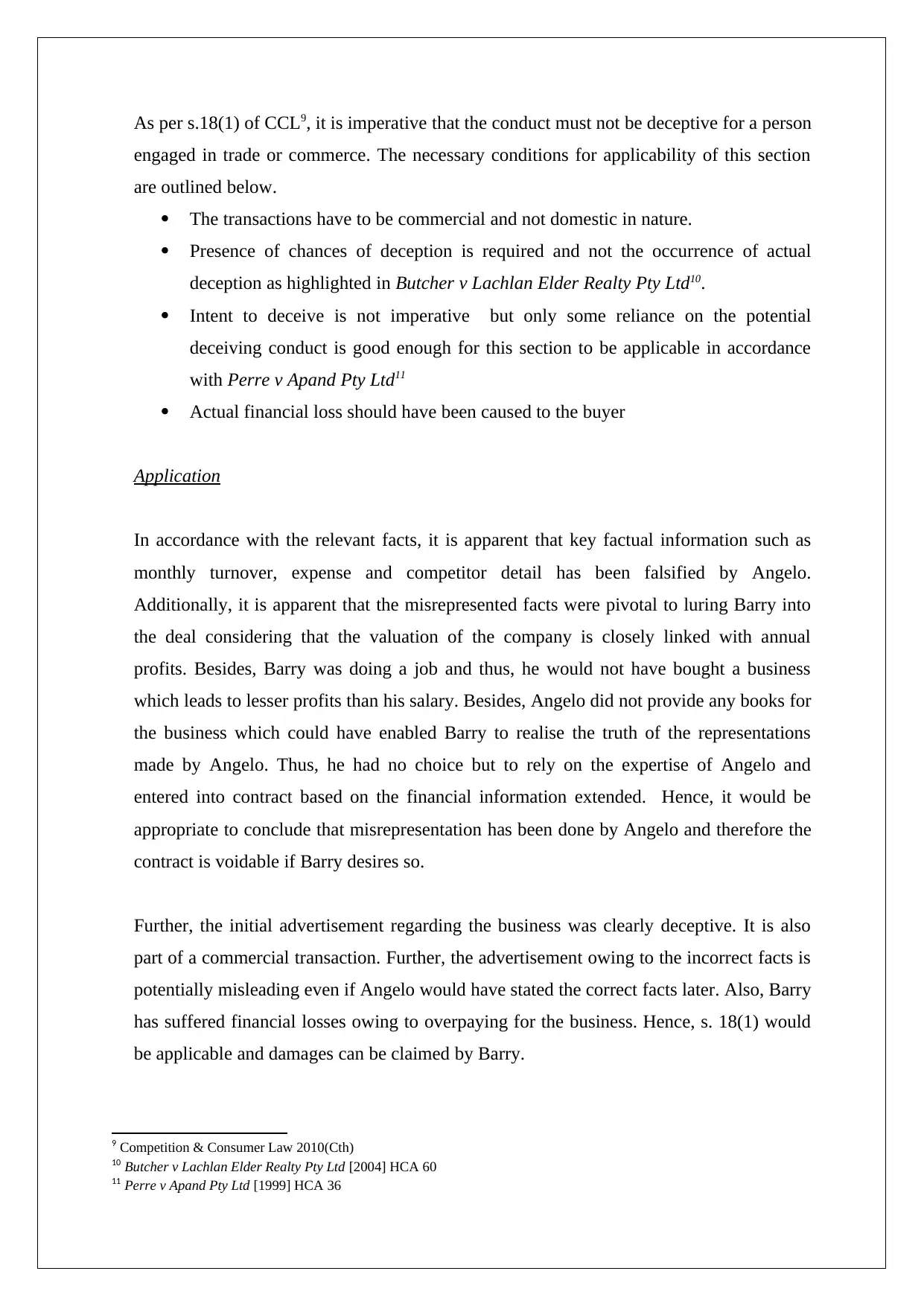
As per s.18(1) of CCL9, it is imperative that the conduct must not be deceptive for a person
engaged in trade or commerce. The necessary conditions for applicability of this section
are outlined below.
The transactions have to be commercial and not domestic in nature.
Presence of chances of deception is required and not the occurrence of actual
deception as highlighted in Butcher v Lachlan Elder Realty Pty Ltd10.
Intent to deceive is not imperative but only some reliance on the potential
deceiving conduct is good enough for this section to be applicable in accordance
with Perre v Apand Pty Ltd11
Actual financial loss should have been caused to the buyer
Application
In accordance with the relevant facts, it is apparent that key factual information such as
monthly turnover, expense and competitor detail has been falsified by Angelo.
Additionally, it is apparent that the misrepresented facts were pivotal to luring Barry into
the deal considering that the valuation of the company is closely linked with annual
profits. Besides, Barry was doing a job and thus, he would not have bought a business
which leads to lesser profits than his salary. Besides, Angelo did not provide any books for
the business which could have enabled Barry to realise the truth of the representations
made by Angelo. Thus, he had no choice but to rely on the expertise of Angelo and
entered into contract based on the financial information extended. Hence, it would be
appropriate to conclude that misrepresentation has been done by Angelo and therefore the
contract is voidable if Barry desires so.
Further, the initial advertisement regarding the business was clearly deceptive. It is also
part of a commercial transaction. Further, the advertisement owing to the incorrect facts is
potentially misleading even if Angelo would have stated the correct facts later. Also, Barry
has suffered financial losses owing to overpaying for the business. Hence, s. 18(1) would
be applicable and damages can be claimed by Barry.
9 Competition & Consumer Law 2010(Cth)
10 Butcher v Lachlan Elder Realty Pty Ltd [2004] HCA 60
11 Perre v Apand Pty Ltd [1999] HCA 36
engaged in trade or commerce. The necessary conditions for applicability of this section
are outlined below.
The transactions have to be commercial and not domestic in nature.
Presence of chances of deception is required and not the occurrence of actual
deception as highlighted in Butcher v Lachlan Elder Realty Pty Ltd10.
Intent to deceive is not imperative but only some reliance on the potential
deceiving conduct is good enough for this section to be applicable in accordance
with Perre v Apand Pty Ltd11
Actual financial loss should have been caused to the buyer
Application
In accordance with the relevant facts, it is apparent that key factual information such as
monthly turnover, expense and competitor detail has been falsified by Angelo.
Additionally, it is apparent that the misrepresented facts were pivotal to luring Barry into
the deal considering that the valuation of the company is closely linked with annual
profits. Besides, Barry was doing a job and thus, he would not have bought a business
which leads to lesser profits than his salary. Besides, Angelo did not provide any books for
the business which could have enabled Barry to realise the truth of the representations
made by Angelo. Thus, he had no choice but to rely on the expertise of Angelo and
entered into contract based on the financial information extended. Hence, it would be
appropriate to conclude that misrepresentation has been done by Angelo and therefore the
contract is voidable if Barry desires so.
Further, the initial advertisement regarding the business was clearly deceptive. It is also
part of a commercial transaction. Further, the advertisement owing to the incorrect facts is
potentially misleading even if Angelo would have stated the correct facts later. Also, Barry
has suffered financial losses owing to overpaying for the business. Hence, s. 18(1) would
be applicable and damages can be claimed by Barry.
9 Competition & Consumer Law 2010(Cth)
10 Butcher v Lachlan Elder Realty Pty Ltd [2004] HCA 60
11 Perre v Apand Pty Ltd [1999] HCA 36
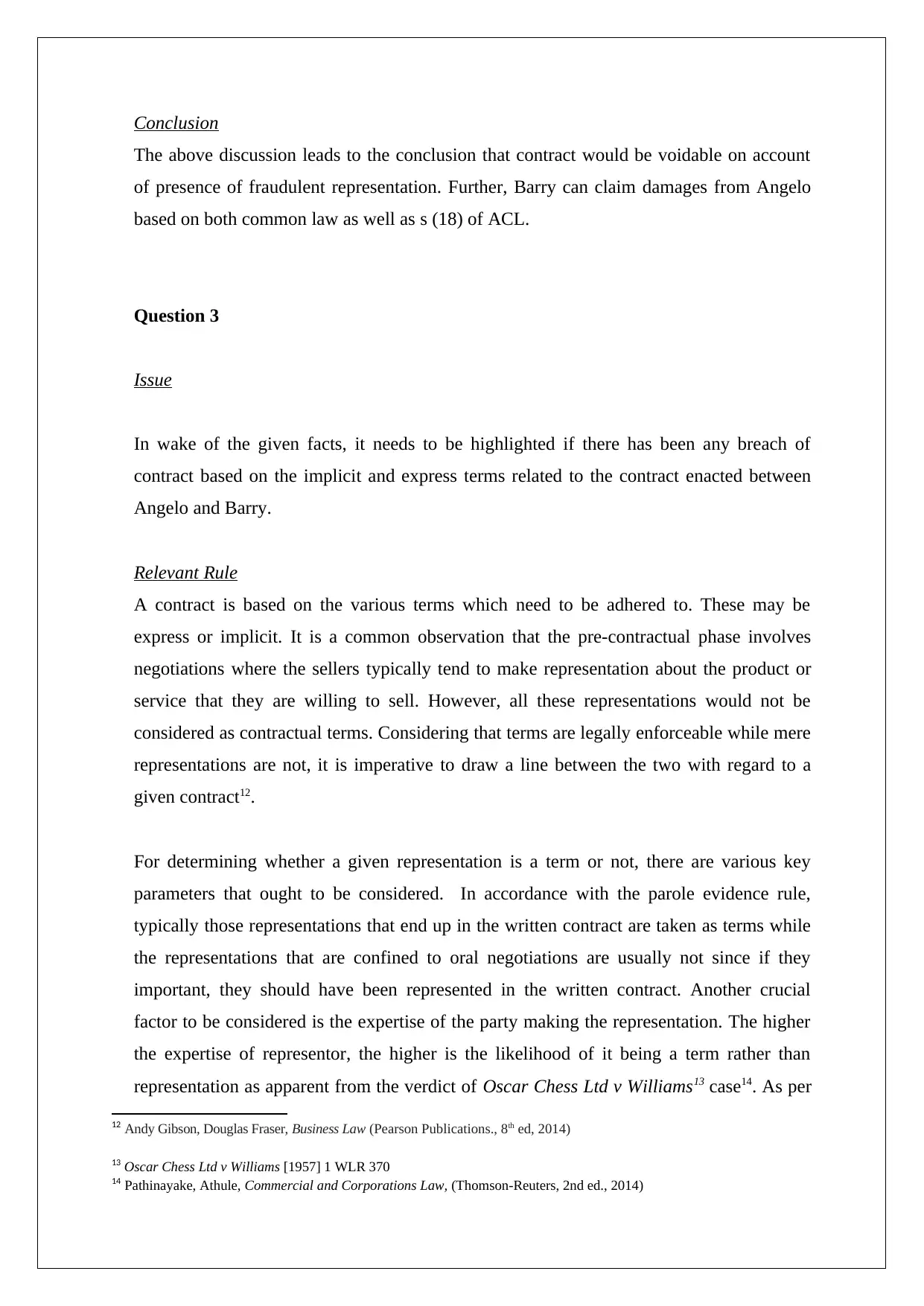
Conclusion
The above discussion leads to the conclusion that contract would be voidable on account
of presence of fraudulent representation. Further, Barry can claim damages from Angelo
based on both common law as well as s (18) of ACL.
Question 3
Issue
In wake of the given facts, it needs to be highlighted if there has been any breach of
contract based on the implicit and express terms related to the contract enacted between
Angelo and Barry.
Relevant Rule
A contract is based on the various terms which need to be adhered to. These may be
express or implicit. It is a common observation that the pre-contractual phase involves
negotiations where the sellers typically tend to make representation about the product or
service that they are willing to sell. However, all these representations would not be
considered as contractual terms. Considering that terms are legally enforceable while mere
representations are not, it is imperative to draw a line between the two with regard to a
given contract12.
For determining whether a given representation is a term or not, there are various key
parameters that ought to be considered. In accordance with the parole evidence rule,
typically those representations that end up in the written contract are taken as terms while
the representations that are confined to oral negotiations are usually not since if they
important, they should have been represented in the written contract. Another crucial
factor to be considered is the expertise of the party making the representation. The higher
the expertise of representor, the higher is the likelihood of it being a term rather than
representation as apparent from the verdict of Oscar Chess Ltd v Williams13 case14. As per
12 Andy Gibson, Douglas Fraser, Business Law (Pearson Publications., 8th ed, 2014)
13 Oscar Chess Ltd v Williams [1957] 1 WLR 370
14 Pathinayake, Athule, Commercial and Corporations Law, (Thomson-Reuters, 2nd ed., 2014)
The above discussion leads to the conclusion that contract would be voidable on account
of presence of fraudulent representation. Further, Barry can claim damages from Angelo
based on both common law as well as s (18) of ACL.
Question 3
Issue
In wake of the given facts, it needs to be highlighted if there has been any breach of
contract based on the implicit and express terms related to the contract enacted between
Angelo and Barry.
Relevant Rule
A contract is based on the various terms which need to be adhered to. These may be
express or implicit. It is a common observation that the pre-contractual phase involves
negotiations where the sellers typically tend to make representation about the product or
service that they are willing to sell. However, all these representations would not be
considered as contractual terms. Considering that terms are legally enforceable while mere
representations are not, it is imperative to draw a line between the two with regard to a
given contract12.
For determining whether a given representation is a term or not, there are various key
parameters that ought to be considered. In accordance with the parole evidence rule,
typically those representations that end up in the written contract are taken as terms while
the representations that are confined to oral negotiations are usually not since if they
important, they should have been represented in the written contract. Another crucial
factor to be considered is the expertise of the party making the representation. The higher
the expertise of representor, the higher is the likelihood of it being a term rather than
representation as apparent from the verdict of Oscar Chess Ltd v Williams13 case14. As per
12 Andy Gibson, Douglas Fraser, Business Law (Pearson Publications., 8th ed, 2014)
13 Oscar Chess Ltd v Williams [1957] 1 WLR 370
14 Pathinayake, Athule, Commercial and Corporations Law, (Thomson-Reuters, 2nd ed., 2014)
⊘ This is a preview!⊘
Do you want full access?
Subscribe today to unlock all pages.

Trusted by 1+ million students worldwide
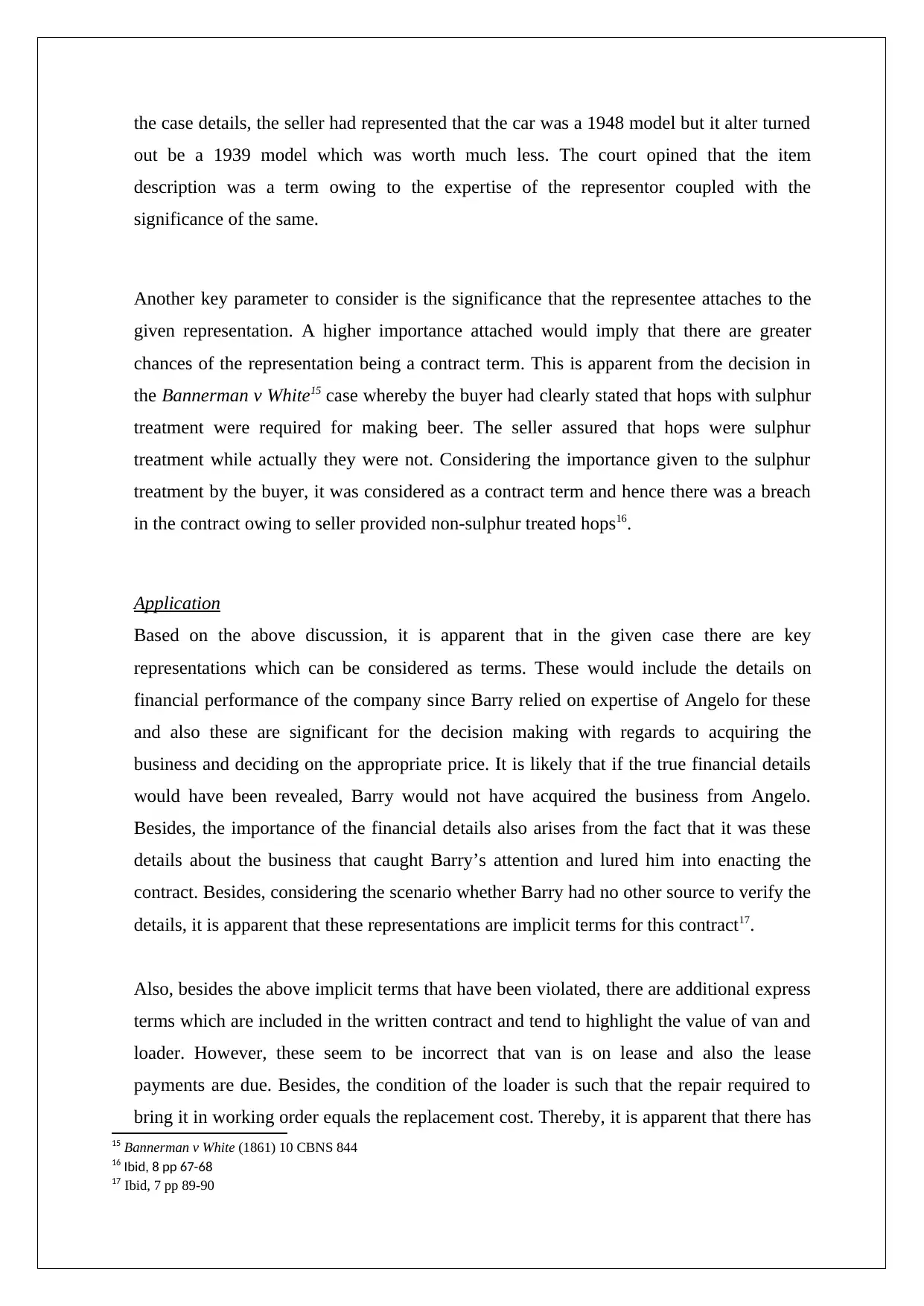
the case details, the seller had represented that the car was a 1948 model but it alter turned
out be a 1939 model which was worth much less. The court opined that the item
description was a term owing to the expertise of the representor coupled with the
significance of the same.
Another key parameter to consider is the significance that the representee attaches to the
given representation. A higher importance attached would imply that there are greater
chances of the representation being a contract term. This is apparent from the decision in
the Bannerman v White15 case whereby the buyer had clearly stated that hops with sulphur
treatment were required for making beer. The seller assured that hops were sulphur
treatment while actually they were not. Considering the importance given to the sulphur
treatment by the buyer, it was considered as a contract term and hence there was a breach
in the contract owing to seller provided non-sulphur treated hops16.
Application
Based on the above discussion, it is apparent that in the given case there are key
representations which can be considered as terms. These would include the details on
financial performance of the company since Barry relied on expertise of Angelo for these
and also these are significant for the decision making with regards to acquiring the
business and deciding on the appropriate price. It is likely that if the true financial details
would have been revealed, Barry would not have acquired the business from Angelo.
Besides, the importance of the financial details also arises from the fact that it was these
details about the business that caught Barry’s attention and lured him into enacting the
contract. Besides, considering the scenario whether Barry had no other source to verify the
details, it is apparent that these representations are implicit terms for this contract17.
Also, besides the above implicit terms that have been violated, there are additional express
terms which are included in the written contract and tend to highlight the value of van and
loader. However, these seem to be incorrect that van is on lease and also the lease
payments are due. Besides, the condition of the loader is such that the repair required to
bring it in working order equals the replacement cost. Thereby, it is apparent that there has
15 Bannerman v White (1861) 10 CBNS 844
16 Ibid, 8 pp 67-68
17 Ibid, 7 pp 89-90
out be a 1939 model which was worth much less. The court opined that the item
description was a term owing to the expertise of the representor coupled with the
significance of the same.
Another key parameter to consider is the significance that the representee attaches to the
given representation. A higher importance attached would imply that there are greater
chances of the representation being a contract term. This is apparent from the decision in
the Bannerman v White15 case whereby the buyer had clearly stated that hops with sulphur
treatment were required for making beer. The seller assured that hops were sulphur
treatment while actually they were not. Considering the importance given to the sulphur
treatment by the buyer, it was considered as a contract term and hence there was a breach
in the contract owing to seller provided non-sulphur treated hops16.
Application
Based on the above discussion, it is apparent that in the given case there are key
representations which can be considered as terms. These would include the details on
financial performance of the company since Barry relied on expertise of Angelo for these
and also these are significant for the decision making with regards to acquiring the
business and deciding on the appropriate price. It is likely that if the true financial details
would have been revealed, Barry would not have acquired the business from Angelo.
Besides, the importance of the financial details also arises from the fact that it was these
details about the business that caught Barry’s attention and lured him into enacting the
contract. Besides, considering the scenario whether Barry had no other source to verify the
details, it is apparent that these representations are implicit terms for this contract17.
Also, besides the above implicit terms that have been violated, there are additional express
terms which are included in the written contract and tend to highlight the value of van and
loader. However, these seem to be incorrect that van is on lease and also the lease
payments are due. Besides, the condition of the loader is such that the repair required to
bring it in working order equals the replacement cost. Thereby, it is apparent that there has
15 Bannerman v White (1861) 10 CBNS 844
16 Ibid, 8 pp 67-68
17 Ibid, 7 pp 89-90
Paraphrase This Document
Need a fresh take? Get an instant paraphrase of this document with our AI Paraphraser
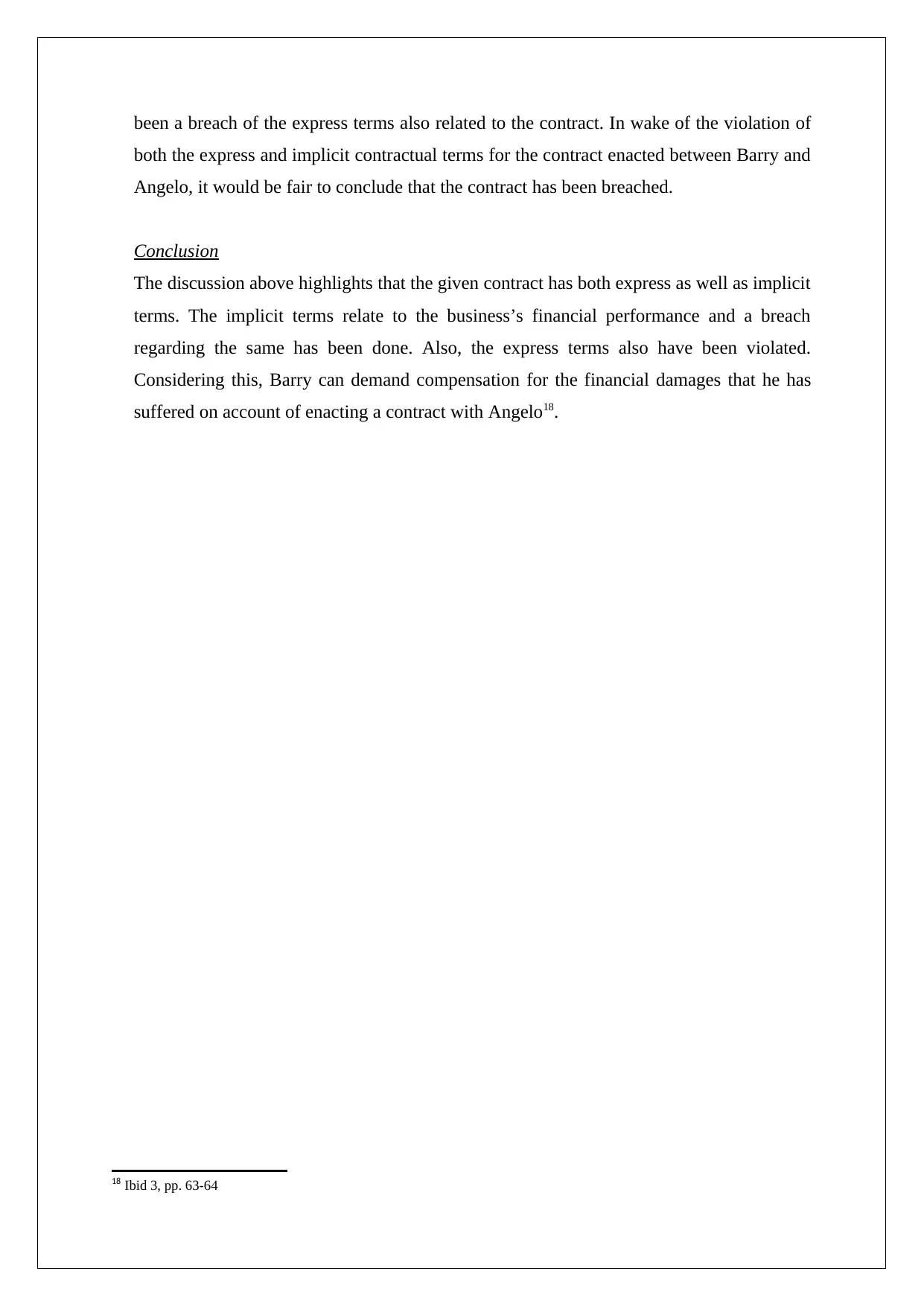
been a breach of the express terms also related to the contract. In wake of the violation of
both the express and implicit contractual terms for the contract enacted between Barry and
Angelo, it would be fair to conclude that the contract has been breached.
Conclusion
The discussion above highlights that the given contract has both express as well as implicit
terms. The implicit terms relate to the business’s financial performance and a breach
regarding the same has been done. Also, the express terms also have been violated.
Considering this, Barry can demand compensation for the financial damages that he has
suffered on account of enacting a contract with Angelo18.
18 Ibid 3, pp. 63-64
both the express and implicit contractual terms for the contract enacted between Barry and
Angelo, it would be fair to conclude that the contract has been breached.
Conclusion
The discussion above highlights that the given contract has both express as well as implicit
terms. The implicit terms relate to the business’s financial performance and a breach
regarding the same has been done. Also, the express terms also have been violated.
Considering this, Barry can demand compensation for the financial damages that he has
suffered on account of enacting a contract with Angelo18.
18 Ibid 3, pp. 63-64
1 out of 8
Related Documents
Your All-in-One AI-Powered Toolkit for Academic Success.
+13062052269
info@desklib.com
Available 24*7 on WhatsApp / Email
![[object Object]](/_next/static/media/star-bottom.7253800d.svg)
Unlock your academic potential
Copyright © 2020–2025 A2Z Services. All Rights Reserved. Developed and managed by ZUCOL.





